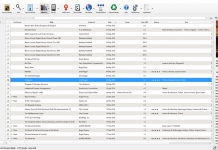 An interesting thing about the latest post from publishing-industry observer Mike Shatzkin, highlighting what he feels were the most important points from the Digital Book World conference he helped run: it largely focuses on DRM. Aside from Matteo Berlucchi’s call for publishers to drop DRM (which I covered here and here), Shatzkin also brings up a point about the relationship of DRM to sales at romance e-bookseller All Romance Ebooks.
An interesting thing about the latest post from publishing-industry observer Mike Shatzkin, highlighting what he feels were the most important points from the Digital Book World conference he helped run: it largely focuses on DRM. Aside from Matteo Berlucchi’s call for publishers to drop DRM (which I covered here and here), Shatzkin also brings up a point about the relationship of DRM to sales at romance e-bookseller All Romance Ebooks.
Shatzkin notes three interesting statistics that came up in All Romance’s presentation at DBW:
- Only 20% of All Romance’s readers strongly resist e-books with DRM.
- 96% of All Romance’s e-book sales by volume are DRM-free.
- 91% of All Romance’s titles are protected by DRM.
He points out:
What this means is that the nine percent of All Romance’s offerings that do not have DRM are selling 96% of their units overall. And since only 20% of their customers find DRM as a strong deterrent to sales, that means those fledglings are outselling all the majors for other reasons.
What might those reasons be? Shatzkin speculates, but doesn’t really come up with any solid reasons. My own speculation is to wonder whether even those people who don’t “resist” DRM could nonetheless be swayed toward embracing DRM-free because they recognize the advantages it has. I know I don’t “resist” e-books from Amazon or Barnes & Noble if they’re not available anywhere else, but I’m more inclined to buy something if I see it’s DRM-free.
But the more interesting thing to me is how much this and other news coming out of DBW suggests that DRM is being discussed at industry events a lot, rather than just being taken for granted as “that thing we don’t publish e-books without.” Might this suggest e-book DRM could be on the beginning of its way out? It still seems a bit unlikely—but then, so did the music industry ditching DRM before it did. How much bigger will Amazon have to get before publishers decide the paper(less) tiger of e-piracy is the secondary threat?

































I am a frequent buyer from All Romance eBooks and have been buying most of my eBooks from them for nearly two years. I think I have bought less than 10 DRM eBooks from them during that time and that was over a year ago. One reason is that I prefer DRM-free eBooks, another is that I like the discounts and offers they provide and the fact that I can shop for books from many of the smaller publishers in one place. The main reason for me, however, is geographical restrictions. As I can no longer purchase many of my former ‘favourite’ authors due to geographical restrictions I had to look elsewhere. Having been forced to give up on 20+ authors published by the big NY publishers I have found new favourites elsewhere. I know that All Romance offers DRM eBooks but I don’t even look at them because I know I won’t be able to puchase them. I also know that I could probably get many of my DRM-free eBooks through Kobo but, quite frankly, it is much easier to purchase from All Romance.
I can’t draw the same conclusions from the data. I’d need to also see a customer skew. It’s quite possible that the 20% of the customers that don’t like DRM are in fact buying 96% of the books on the site.
Is Mr Shatzkin for real ? I find his acceptance, and interpretation, of the data he is quoting to be quite fantastical ….
Let’s take it step by step …
“91% of All Romance’s titles are protected by DRM.” Ok so the VAST and overwhelming majority of Romance eBooks are DRM locked.
“96% of All Romance’s e-book sales by volume are DRM-free” So only 4% of Romance eBook purchases are DRM locked …. and pretty much EVERYONE is buying DRM-free titles.
Yet …
“Only 20% of All Romance’s readers strongly resist e-books with DRM ?”
Really ???????
It seems to me that this ‘survey’ is bonkers.
I wonder how All Romance determined that its customers aren’t resistant to DRM. Since 96% of the content sold is DRM free, that doesn’t seem like a logical conclusion.
I know part of the reason I resist paying print prices for ebooks is the DRM. I also don’t buy from All Romance because it’s too much of a hassle trying to figure out which books are DRM free since my Kindle can’t handle their DRM. So how does All Romance determine how many Kindle customers they lose.
I agree with the commentor on the original post site who asked how much of the *revenue* comes from non-DRM as opposed to DRM. If 96% of the volume is free then it isn’t a convincing argument that DRM stops you getting money.
Now, what might be happening is that rightsholders are saying “we’re giving this away free or nearly-free, as a sample, so we aren’t gonna bother putting DRM, because we don’t plan to make money on it anyway. What we want is for someone to read it and decide they want all the author’s other books–which are $4.99 each, and they *do* have DRM.” It’s just loss-leader advertising.
@Diane – The interpretation of the data above is Mike’s, not necessarily All Romance’s. I’d encourage you to go here and review the actual data: http://www.allromanceebooks.com/survey.html
If/when the survey is repeated, we’ll be asking some more pointed questions about the DRM issue.
People can easily used the advanced search feature on our site to specify the formats they want returned in the search, and many do.
@DensityDuck: The statistics reported were sales statistics, we don’t count a free book as a sale. So, none of the titles reported in those statistics were free. The average price readers paid for a book on our site in 2011 was $4.67. I don’t already have a breakdown of that for DRM v Non-DRM. Glancing at the numbers, I think the DRM average would come in a bit higher. But I don’t think that increase in price is enough to explain the imbalance we’re seeing.